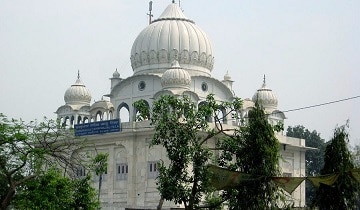One of the most popular hangout spots that DU students as well as Delhites love is Majnu Ka Tilla. This piece is an attempt to trace the lesser known history of such a place.
Majnu Ka Tila has been loved for it’s delicious Tibetan food, some of the specialties being Laphing and Thukpa. The colony has numerous Buddhist monasteries and in a way is a photogenic place. Posing with the prayer wheels is one of the many loved ways one likes to be clicked. Every knows about it for its beautiful Tibetan vibe along with narrow lanes that actually does feel like only a home away from home.
As a street photographer, Majnu Ka Tila is one of the most interesting places to shoot your heart out. Dogs, old ladies, children, everything that exists in the place is something that creates a core memory once you go and capture it.
But this article isn’t a description about Majnu Ka Tila, it’s about the very sanctity that this place has developed over the years– it’s origins. Most of us haven’t even heard of the Majnu Ka Tila Gurudwara. We just go to Majnu Ka Tilla to rewind and relax in the Tibetan Culture that creates a whole different vibe. I personally, am on a look out for hidden or lesser known places, especially since I have come to Delhi and I couldn’t have been happier to find out that traces of Sikhism can be found at this place.
Majnu Ka Tilla literally translates to hillock of Majnu. The name comes after a local Iranian Sufi mystic Abdulla, nick named Majnu met Guru Nanak Dev ji, the first of the ten Sikh Gurus in 1505 during the reign of Sikander Lodhi. The Iranian sufi had come to this mound and made a small hut to spread the word of
God. Impressed by the devotional praise of Shri Guru Nanak, the Sufi followed in the same footsteps and it has been recorded that on 20th July 1505 AD, Guru Nanak Dev ji gave darshan (appeared in a vision) to the Faquir at Amrit Vela. Guru Nanak stayed at this place and on the last day of his stay, he granted a boon to Majnu, the faquir that the place will be famous with his name and his name will remain till the living world.
But the story doesn’t end here. In 1621 AD, Sri Guru Hargobind Sahib ji, the sixth Sikh Guru of the Sikh order, had placed his sacred feet at the same place during the reign of the Mughal emperor Jahangir. Jahangir had ordered the imprisonment of the Guru in Gwalior fort but when he saw the amount of love and devotion the Sangat of Delhi had for the Guru, and on the advice of Sai Miya Mir and other scholars, the Guru and 52 other kings were released. Majnu Ka Tilla was the place where the kings got their rightful kingdoms back.
In later history, Sikh military leader Baghel Singh Dhaliwal built the Majnu ka Tila Gurudwara to commemorate the stay of both Guru Nanak Dev ji and Guru Har Gobind in 1783. Today it is one of oldest existing Sikh shrines in Delhi and the surrounding estate was donated by early 19th-century Sikh emperor, Ranjit Singh .
Isn’t it powerful? To realize that one place, that is famous for its present day cafes and picturesque aura, has actually a deep rooted history? The kind of history that should be known to people but we as youngsters often forget to ignite that curiosity. The curiosity to know about a place that holds a strong and a divine aura. Well, Majnu Ka Tilla is the all in one place that has observed so many historic events allowing us to understand the collectivistic cultural and religious identities one place carries. And therefore, this celebrated place has left an imprint on our minds when we speak about a subject like secularism. The place has revered different religions together and becomes a vision for the citizens of India.
Image Credits: tripadvisor.in
Read Also: DUB Travels: Majnu Ka Tilla
Aanya Mehta
[email protected]





Comments are closed.